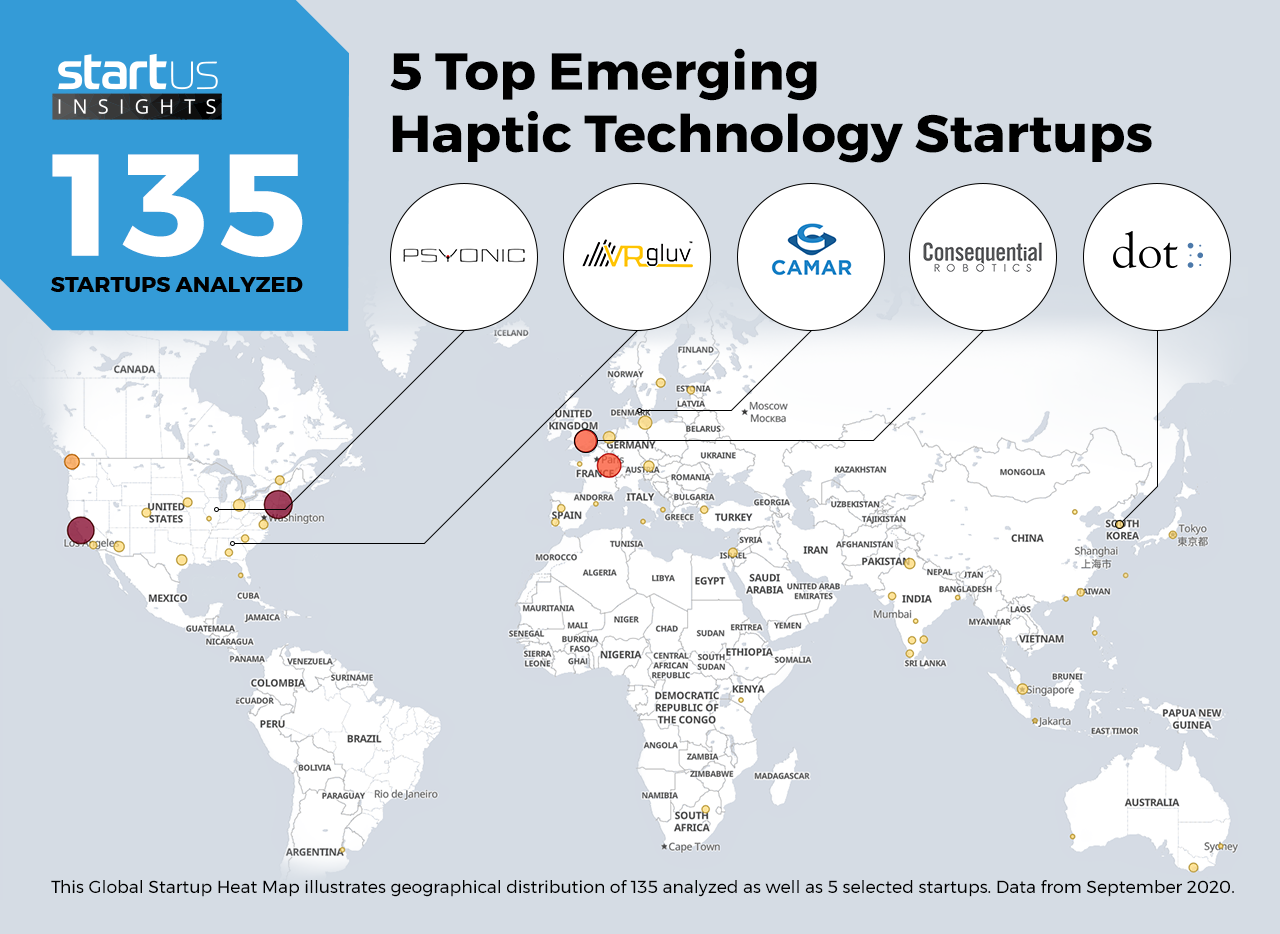Our Innovation Analysts recently looked into emerging technologies and up-and-coming startups. As there is a large number of startups working on a wide variety of solutions, we want to share our insights with you. This time, we are taking a look at 5 promising haptic technology startups.
Heat Map: 5 Top Haptic Technology Startups
Using our StartUs Insights Discovery Platform, covering 1.379.000+ startups & scaleups globally, we looked at innovation in the field of haptic technology. For this research, we identified 135 relevant solutions and picked 5 to showcase below. These companies were chosen based on a data-driven startup scouting approach, taking into account factors such as location, founding year, and technology among others. Depending on your specific criteria, the top picks might look entirely different.
The Global Startup Heat Map below highlights 5 startups & scaleups developing innovative haptic technology solutions. Moreover, the Heat Map reveals regions that observe a high startup activity and illustrates the geographic distribution of all 135 companies we analyzed for this specific topic.
CAMAR – Tactile Touch Screens
Touch screen interfaces are now everywhere, from personal devices to control panels in industrial applications. In many situations, their use often distracts the user since they have to look at the screen to operate it – an example are dashboards in vehicles. Tackling this challenge, tactile touch screens use haptic feedback to deliver the experience of physical buttons in touch screens.
Danish startup CAMAR develops a haptic software solution for touch screens. The startup’s proprietary and patented TacTile Pinpoint technology uses the standard vibration motor in electronic devices to imitate a mechanical button. Further, the proactive feature allows users to identify where an app is located on a screen without having to look at it. CAMAR’s solution finds applications in the automotive, shipping, and manufacturing industries.
VRgluv – Virtual Reality (VR) Training
Startups are using virtual reality technology to develop solutions that train workers across different sectors. Prominent examples include surgeons-to-be learning to operate on patients as well as factory workers learning to operate heavy machinery. However, as real as virtual reality may seem, solutions often do not feel real to the trainees because of a lack of a sense of touch. Therefore, startups are exploring haptic technology to overcome this barrier.
The US-based startup VRgluv offers a wireless force-feedback haptic glove for virtual reality training solutions. The startup uses occlusion and drift-free technology to mirror the motion of the virtual hands with real hands. As soon as a user touches a virtual object, the glove uses strong haptic forces to mimic the object’s shape, size, and stiffness. The dynamic, variable force sensations allow users to feel the difference between rigid, soft, and moving objects.
Consequential Robotics – Assistive Robots
Collaborative robots, also called cobots, work alongside human workers in the manufacturing and other sectors. Some of them, such as fruit-picking robots or surgical robots, often handle very delicate objects and need to mimic the human touch as closely as possible. Haptic technology-based solutions allow robotic arms to precisely control the force they use in any context, leading to an enhanced human-robot interaction.
British startup Consequential Robotics develops assistive robots for the healthcare and education sectors. The robots feature capacitive touch sensors that make them more interactive than traditional robots. Additionally, the robots also feature sensors for ultrasonic ranging, stereo vision, hearing, proprioception, and temperature. The startup’s solution finds applications in next-gen companion robots, robot-assisted therapy, teaching, and public engagement.
Dot Incorporation – Piezoelectric Haptics
Piezoelectric haptics work on the principle of the piezoelectric effect wherein electric charge accumulates in certain materials in response to mechanical stress. Using this concept enables high definition haptics with faster response time, higher bandwidth, no mechanical sounds, and stronger vibrations. Startups are working on solutions to the challenge of high power consumption that limits the widespread adoption of piezoelectric haptics.
South Korean startup Dot Incorporation uses haptics to produce smart devices for the visually impaired. The Dot Watch enables calls, messaging, and other features of smartwatches, all in braille. Further, the Dot Mini is a smart media device that provides access to books, documents, and music. These devices use the startup’s piezoelectric cell to facilitate tactile literacy.
PSYONIC – Bionic Prosthesis
A large fraction of amputees use some form of prosthesis, some of which allow the wearer’s muscles to control the finer movements of the prosthesis. However, in the absence of tactile feedback, even routine jobs such as holding objects prove to be very difficult for people with prosthetic arms. Haptic technology adds tactile feedback to the prosthesis and gives muscle sense to the wearer.
The US-based startup PSYONIC uses haptic technology to provide advanced, bionic prosthesis. The Ability Hand features multitouch sensory feedback through highly sensitive pressure sensors. The affordable and accessible prosthesis also features carbon fiber palms and brushless motor control for fast individual finger movements.
What About The Other 130 Solutions?
While we believe data is key to creating insights it can be easy to be overwhelmed by it. Our ambition is to create a comprehensive overview and provide actionable innovation intelligence that enables you to achieve your goals faster. The 5 haptic technology solutions showcased above are promising examples out of 135 we analyzed for this article. To identify the most relevant solutions based on your specific criteria, get in touch.









